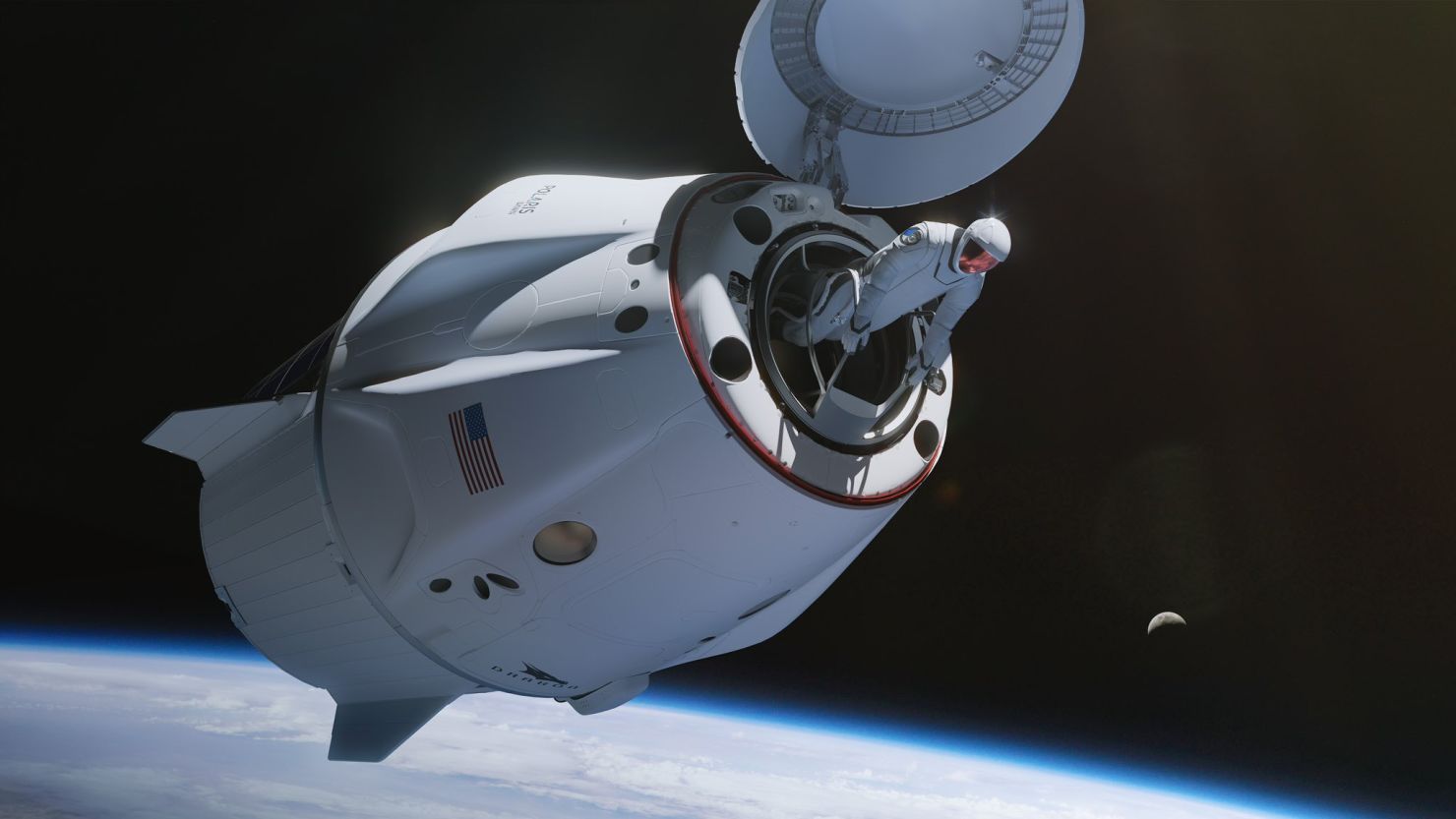Blog Credit : Trupti Thakur
Image Courtesy : Google
The First Private Spacewalk
The Polaris Dawn mission is set to achieve remarkable feats in space exploration. It aims to be the first private mission where astronauts will perform a spacewalk at a record-breaking altitude of 700 kilometers (435 miles) above Earth. This altitude is higher than the International Space Station (ISS), making it a significant milestone in human spaceflight.
Understanding the Van Allen Belts
During the mission, the crew will travel through the Van Allen Belts, which are two rings of charged particles surrounding Earth, held in place by Earth’s magnetic field. These belts are filled with radiation that can be harmful to astronauts. The inner belt contains high-energy particles from cosmic rays, while the outer belt has particles from the sun. Studying how this radiation affects humans is crucial for future space missions, especially those that will travel farther into space.
Mission Crew and Their Goals
The Polaris Dawn mission is led by Jared Isaacman, a billionaire entrepreneur. The crew also includes Scott Poteet, Sarah Gillis, and Anna Menon. Besides performing a spacewalk, the crew will test new SpaceX spacesuits designed to protect astronauts in high-radiation environments.
Health Research and Space Travel
One of the key goals of Polaris Dawn is to gather data on how space travel affects human health. The crew will collect samples for Biobanks, which are research facilities that store biological materials. The focus will be on studying conditions like Spaceflight Associated Neuro-ocular Syndrome (SANS), which affects vision, and decompression sickness (DCS), which can occur when returning from space. The mission will also test new communication technologies using SpaceX’s Starlink satellite network. The goal is to improve how we communicate during space missions, which will be important for future missions to the moon and Mars.
Future Polaris Missions
Jared Isaacman has planned two more Polaris missions after this one. The second mission will focus on pushing the boundaries of human space exploration and conducting scientific research. The third mission will be a crewed test flight for SpaceX’s Starship, a spacecraft designed for deep space missions. The Polaris Dawn mission is scheduled to launch on August 26, 2024, though this date could change due to various factors.
- SpaceX’s astronauts will be the first non-government astronauts to attempt a spacewalk as part of the Polaris Dawn mission.
- The mission will also test SpaceX’s new, slimmer spacesuit, and a Crew Dragon vehicle that was modified so it can open its hatch door in the vacuum of space, meaning it does not require an airlock.
- SpaceX officials and the Polaris crew said during a news conference on Monday they have planned for an array of contingency scenarios if something during the mission goes wrong, such as an oxygen leak or failure to reseal the hatch door, but they did not detail what those were.
SpaceX’s attempt at the first ever private spacewalk next week will be a test of trailblazing equipment, including slim spacesuits and a cabin with no airlock, in one of the riskiest missions yet for Elon Musk’s space company.
A billionaire entrepreneur, a retired military fighter pilot and two SpaceX employees are poised to launch on Tuesday aboard a modified Crew Dragon craft, before embarking on a 20-minute spacewalk 434 miles into space two days later.
Until now, walking into the empty expanse of space has only been attempted by government astronauts on the International Space Station (ISS), 250 miles above Earth.
MUSK’S SPACEX TAKES BOLD STEP BEYOND SPACE STATION ON THE WAY TO MAKING HUMANITY AN ‘INTERPLANETARY SPECIES’
SpaceX’s five-day mission – dubbed Polaris Dawn – will swing in an oval-shaped orbit, passing as close to Earth as 118 miles and as far as 870 miles, the farthest any humans will have ventured since the end of the United States’ Apollo moon program in 1972.
Crew members, including billionaire Jared Isaacman, will don SpaceX’s new, slimline spacesuits in a Crew Dragon vehicle that was modified so it can open its hatch door in the vacuum of space – an unusual process that removes the need for an airlock.
“They’re pushing the envelope in multiple ways,” retired NASA astronaut Garrett Reisman said in an interview. “They’re also going to a much higher altitude, with a more severe radiation environment than we’ve been to since Apollo.”
The mission has been bankrolled by Isaacman, the founder of electronic payment company Shift4. He has declined to say how much he has spent, but it is estimated to be over $100 million.
Joining him will be mission pilot Scott Poteet, a retired U.S. Air Force lieutenant colonel, and SpaceX employees Sarah Gillis and Anna Menon, both senior engineers at the company.
For SpaceX, which has pioneered cheap, reusable rockets and expensive private spaceflight, the mission is an opportunity to advance technologies that could be used on the moon and Mars.
Far outside the protective bubble of Earth’s atmosphere, the electronics and shielding on Crew Dragon and spacesuits will be tested as they pass through parts of the Van Allen belt, an area where charged particles streaming mainly from the sun can disrupt satellites’ electronics and affect human health.
“That’s an additional risk that you don’t face when you just stay in low-Earth orbit and go up to the ISS,” Reisman said.
SpaceX’s new kind of spacewalk
The Polaris spacewalk will take place on the mission’s third day, but preparation will begin about 45 hours in advance.
The gumdrop-shaped Crew Dragon’s entire cabin will be depressurized and exposed to the vacuum of space. While only two of the astronauts will float outside, tethered by an oxygen line, the whole crew will depend on their spacesuits for life support.
Days before the spacewalk, the crew will begin a “pre-breathe” process to fill the cabin with pure oxygen and remove any nitrogen from the air.
Nitrogen, if present in astronauts’ bloodstreams in space, could form bubbles, block blood flow and lead to decompression sickness, known as “the bends,” as with scuba divers who return too quickly to the water’s surface.
The crew will use an ultrasound device to monitor any bubble formation, one of many tools to be used in the mission to inform dozens of scientific experiments, providing researchers a rare peek into how astronauts might fare on the moon’s surface or elsewhere in deep space.
“It gives us a very unique opportunity to test these vehicles in such a very unique environment,” said Emmanuel Urquieta, vice chair for aerospace medicine at the University of Central Florida’s internal medicine department.
While astronaut safety on NASA missions is rigorously overseen by the agency, there are no such U.S. standards or laws for spaceflight safety in private missions like Polaris.
SpaceX officials and the Polaris crew said during a Monday news conference they have planned for an array of contingency scenarios if something during the mission goes wrong, such as an oxygen leak or failure to reseal the hatch door, but they did not detail what those were.
Reisman said he knows the Polaris crew and believes they are prepared to handle any unexpected mishaps.
“But there’s not a lot of room for error,” he said.
Blog By : Trupti Thakur

26
AugThe First Private SpaceWalk
Aug 26, 2024Recent Blog
Quantum Gravity Gradiometer PathFinderApr 28, 2025
The TechKriti 2025Apr 26, 2025
India’s First Quantum Computing VillageApr 24, 2025
India’s Achievement In QKDApr 22, 2025
The V2G TechnologyApr 21, 2025




